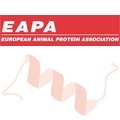 The recent outbreak of PEDv in North America has raised concerns over these type of viruses being spread by animal by-products, including blood products such as animal plasma. However, several factors associated with the production of plasma, such as processing temperatures and collection standards make plasma a safe ingredient. In addition plasma is made from healthy animals slaughtered for human consumption.
The recent outbreak of PEDv in North America has raised concerns over these type of viruses being spread by animal by-products, including blood products such as animal plasma. However, several factors associated with the production of plasma, such as processing temperatures and collection standards make plasma a safe ingredient. In addition plasma is made from healthy animals slaughtered for human consumption.
Plasma is commonly used in post-weaning piglet diets in most of the world because it improves the health of the animal by helping to bridge the gap between the end of the colostrum supplied by the mother and the immunity developed by the piglet itself, which is a critical phase in pig development. Plasma proteins in piglet diets shall be regarded as colostrum extenders. In addition the making of plasma adds value to a by-product, which in the past its disposal was causing serious environmental problems.
A large number of feeding trials have been carried out to demonstrate that the inclusion of plasma in post-weaning diets improves feed efficiency, average daily gain and gain to feed comparing to milk protein and soy protein. This has a significant impact reducing piglet mortality and morbidity, which are two of the serious challenges faced by pig farmers. In addition there are studies that show that plasma is a good alternative to reduce the use of antibiotics.
In addition the industry has being carrying out extensive biosecurity research for many years:
- Efficacy of spray-drying to reduce infectivity of pseudorabies and porcine reproductive and respiratory syndrome (PRRS) viruses and seroconversion in pigs fed diets containing spray-dried animal plasma published in the Journal of Animal Science in 2005 (Polo et al; JAS 83:1933-1938).
- Lack of transmission of porcine circovirus type 2 to weanling pigs by feeding them spray-dried porcine plasma published in The Veterinary Record of November 2008 (Pujols et al; Vet Record 163:536-538).
- Inactivation of swine vesicular disease virus in porcine plasma by spray drying published in the American Association of Swine Veterinarians in 2007 (Pujols et al; AASW Proceeding 281-283).
- Commercial spray-dried porcine plasma contains high amounts of PCV2 DNA and high levels of anti-PCV2 antibodies but is not infective to naïve pigs published in Proceedings of the International Pig Veterinary Society in 2010. (Opriessnig et al; IPVS Proceeding).
- In March of 2014 a swine bioassay was performed at the University of Minnesota to evaluate the infectiousness of feed samples that had tested positive for PED virus by PCR (Department of Veterinary Polulation, University of Missesota, St. Paul, MN).
In these articles the researchers have concluded that commercial spray- dried plasma is a safe ingredient regarding the potential transmission of viruses of concern of the swine industry. We have also proven that commercial plasma is not a vehicle of transmission of high resistant viruses such as porcine circovirus
type 2 (PCV-2) and porcine parvovirus (PPV). In addition the trials have shown that some of the processing steps in the manufacturing of plasma like the spray drying process can be regarded as a very efficient pasteurization step in the elimination of bacteria and viruses of concern like Porcine Reproductive and Respiratory Syndrom (PRRS), Auzesky virus (PRV) and swine vesicular disease (SVD).
The industry has also artificially spiked plasma with viruses before spray drying and demonstrated that they were eliminated after the spray dry process.
These results, in addition to the experience in feeding piglets around the world provide strong evidence regarding the safety of commercial plasma.

April 3, 2014 - EAPA




